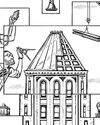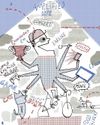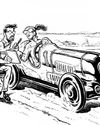
Every organization today may find itself heading toward an abrupt environmental shift that poses an existential threat, a transformational opportunity, or both. The disruption already happening across all domains is staggering, and it’s picking up speed. But leaders confronting such changes start at a disadvantage. Evolution has endowed humans with traits that don’t mix well with complexity and uncertainty, as such environments tend to make people risk-averse, either impulsive or reluctant to act, and focused on fending off dangers. To thrive in the years ahead, all organizations, both public and private, will need to make a concerted investment in the knowledge, capabilities, processes, and cultures that foster a distinctive and all-too-rare organizational quality: agility.
The term agility is used in a range of contexts. Freestyle rappers refer to mental agility, as do chess players and psychologists. Business executives pursue agile marketing and supply chain strategies. We define agility as “the organizational capacity to effectively detect, assess, and respond to environmental changes in ways that are purposeful, decisive, and grounded in the will to win.” Agile organizations possess both strategic and tactical strengths. Strategic agility enables entire organizations to move with the speed of relevance: to detect and assess major trends and environmental changes and dynamically adapt their strategic visions, business models, human capital, and campaign plans. Tactical agility allows employees to move with the speed of the challenge: to take smart risks.
Esta historia es de la edición Summer 2020 de strategy+business.
Comience su prueba gratuita de Magzter GOLD de 7 días para acceder a miles de historias premium seleccionadas y a más de 9,000 revistas y periódicos.
Ya eres suscriptor ? Conectar
Esta historia es de la edición Summer 2020 de strategy+business.
Comience su prueba gratuita de Magzter GOLD de 7 días para acceder a miles de historias premium seleccionadas y a más de 9,000 revistas y periódicos.
Ya eres suscriptor? Conectar

Transforming information into insight
Focus on six organizational elements to build a world-class data and insights capability.

THE URGENT NEED FOR SOPHISTICATED LEADERSHIP
The pandemic has highlighted a series of paradoxes inherent to the work of leaders. What comes next will depend on how well leaders face up to them.

The road to successful change is lined with trade-offs
Rather than trying to convince people your change initiative is the right one, invite them to talk openly about what it might take to implement it: the good, the bad, and the frustrating.

Sustaining productivity virtually
Maintaining productivity levels among remote employees is an enduring challenge. Here are five ways to help businesses and employees thrive while people work at home.

FORWARD TO normal
Entertainment and media companies are building business models that are resilient to the enduring changes in consumer behavior ushered in by COVID-19.

How leaders can promote racial justice in the workplace
Embrace four principles to turn today’s diversity, equity, and inclusion initiatives into sustained progress.

CREATING THE OFFICE OF THE FUTURE
In a remodeled world, it is vital for companies to reinvent ways of working.

Consumer companies must take leaps, not steps
As shoppers show how quickly they can adapt to external shocks, retailers will need to radically reconfigure their business models.

Businesses can fast-track innovation to help during a crisis
“Unrealistic” timelines can actually work. Here’s how.

Agility and experience management work better together
Many companies achieve early wins with separate transformational efforts, then stall. But if combined and enhanced using “return on experience,” or ROX, measures, these two programs can unlock each other’s potential.